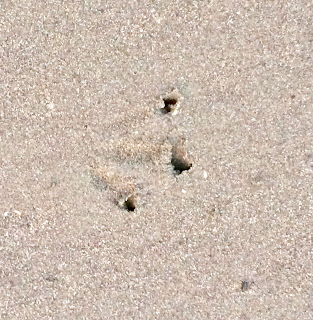 |
| A trail of footprints being examined by volunteers |
 |
| A set of little penguin or kororā footprints. |
 |
| A kororā little penguin left these tracks |
 |
| A single footprint showing deep claw marks |
 |
| Kororā from my book "Whose Feet are These?" illustrated by Fraser Williamson |
 |
| Citizen scientists at work, that's me in front! |
 |
| Tyre sea wall on Paekakariki Beach |
 |
| Nesting kororā |
Finding other footprints
Finding animal footprints on the beach, in a muddy estuary or along a tramping track can be fascinating. I've been excited finding kiwi foot prints (and beak marks) on Rakiura Stewart Island, hoping that I might find a kiwi around the corner.
On a sandy beach or estuary there can be quite a muddle of different footprints, and it can be fun to work out whose prints are whose. See the link to NZ Tracker below.
Sometimes footprints are those of predators or other pests. A tracking tunnel might reveal geckos or mice are in the area. Or a muddy tramping track could show that deer or pigs are around. Check out Pest Detective for help with pest identification.
Citizen scientists can use footprints to learn about wildlife, for example, using tracking tunnels to find out what animals live in a particular habitat, or counting footprints to estimate the population size. See more citizen science ideas in "New Zealand Nature Heroes".
Citizen scientists are volunteers who collect data and information which scientists can use.
Help with identifying footprints:
Pest detective for pest and predator prints http://www.pestdetective.org.nz/culprits
Identification of tracks found on sand, birds, mammals and other tracks http://nztracker.org/index.html
Or use iNaturalist to report footprint sightings and get help with identification iNaturalist.nz/home
 |
| Here are some other tracks we found near the penguin tracks. Can you tell whose tracks these might be using Pest Detective or NZ Tracker? |
Tips for looking after kororā and other sea birds
If you have pets, keep your dog on a lead when at the beach and keep your cat inside at night.
Join a group that builds penguin boxes, monitors pest traps or helps publicise the plight of penguins.
Acknowledgements: Photos by Sue Blaikie and Gillian Candler
No comments:
Post a Comment